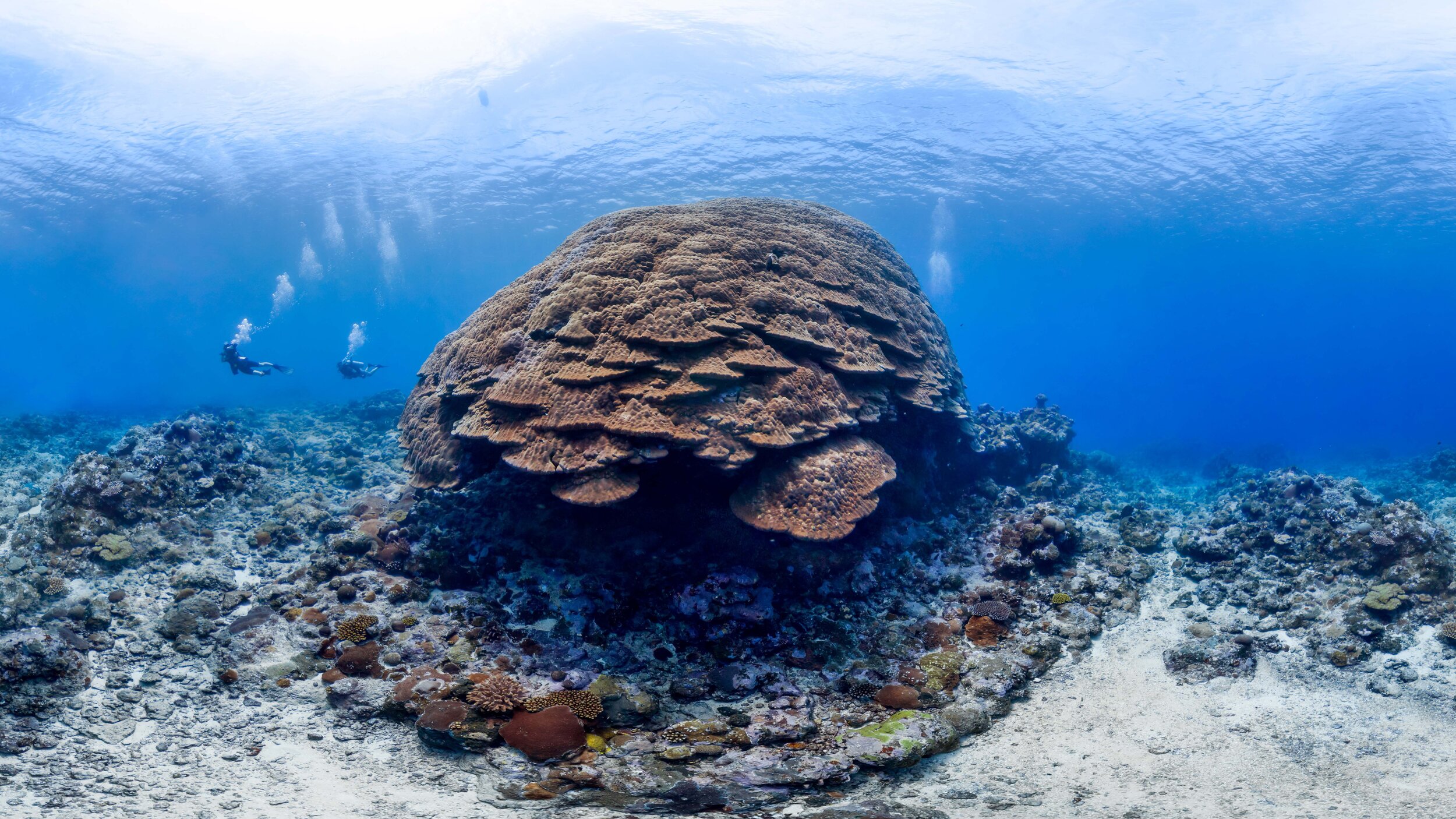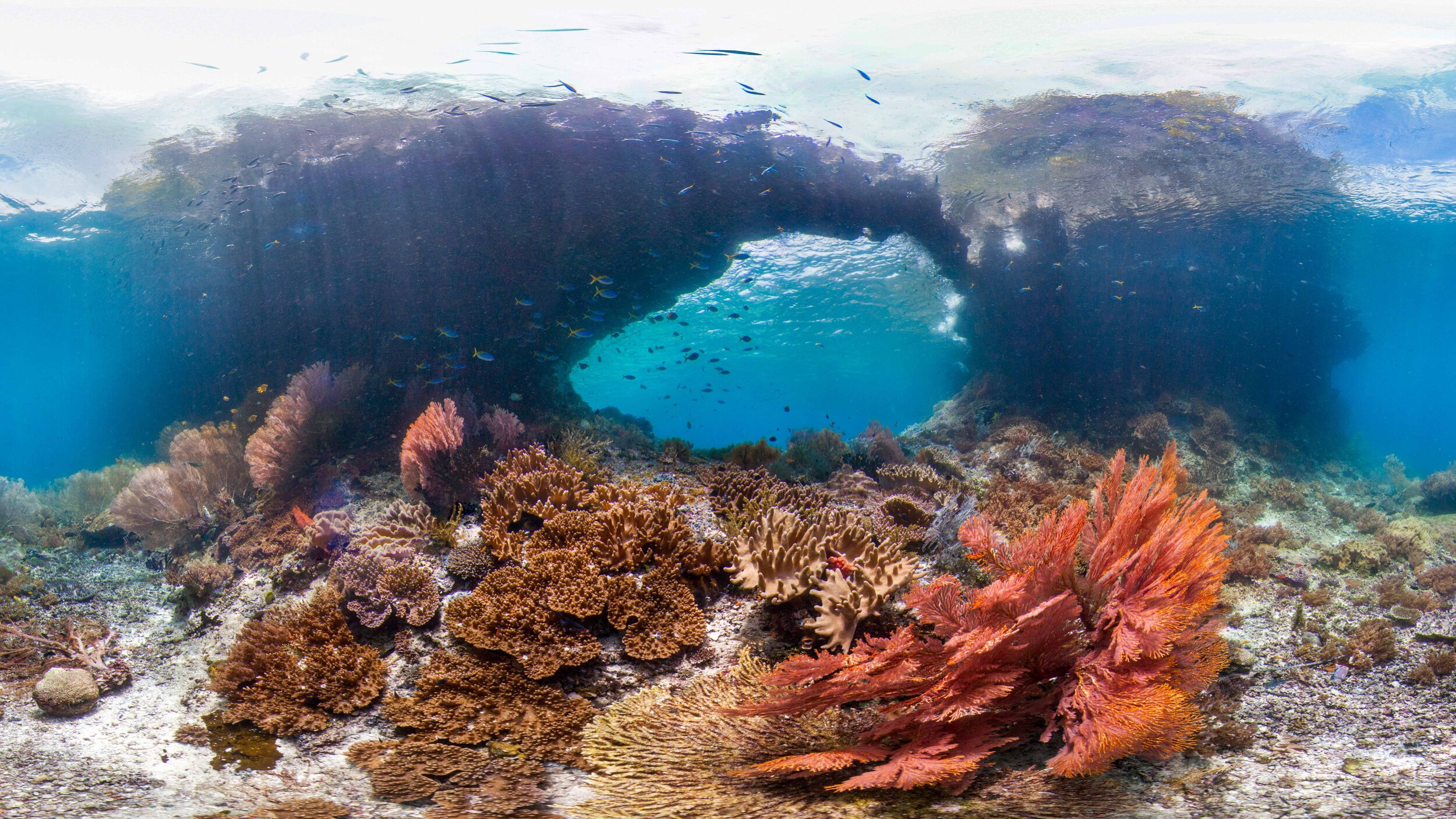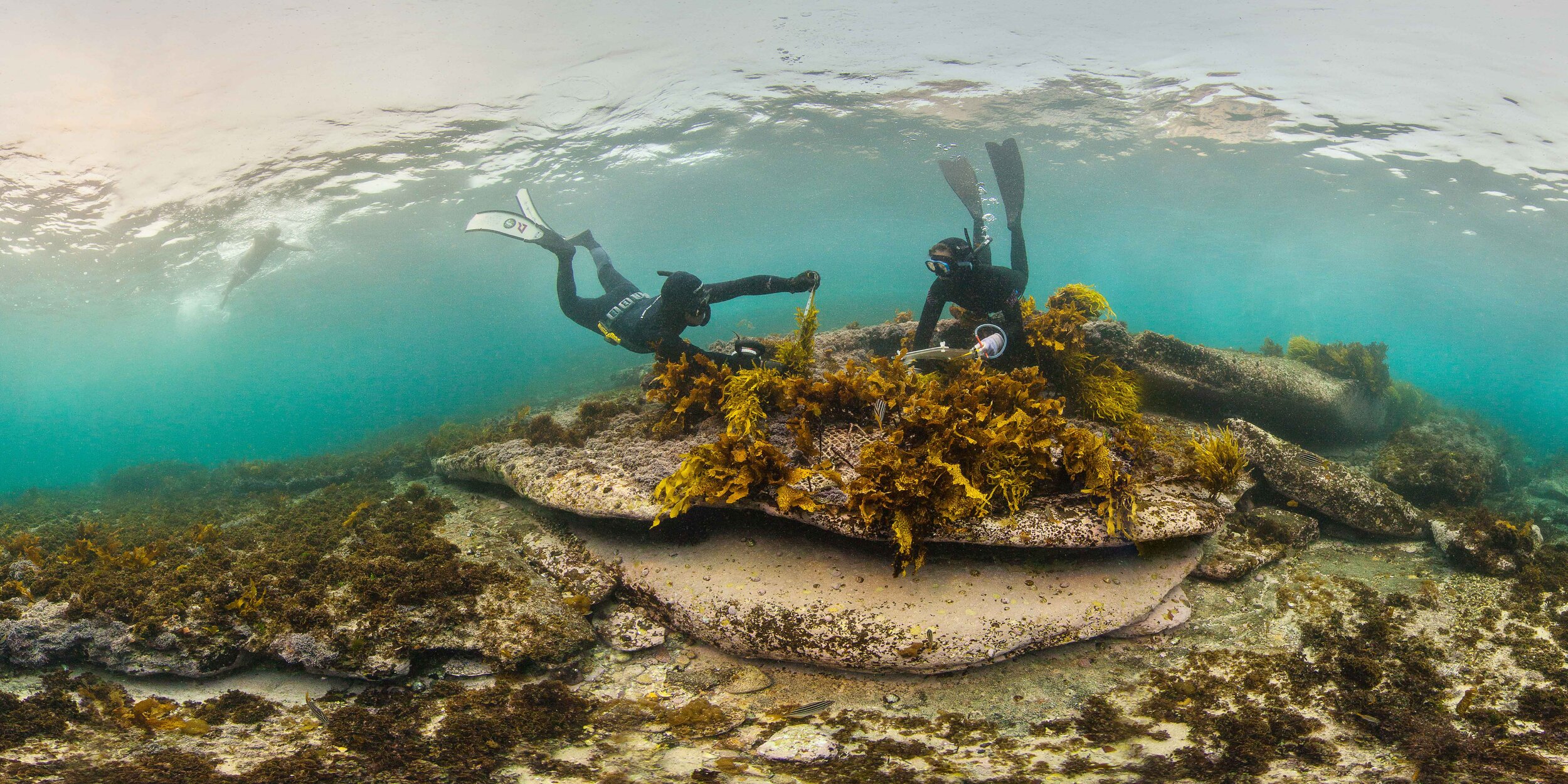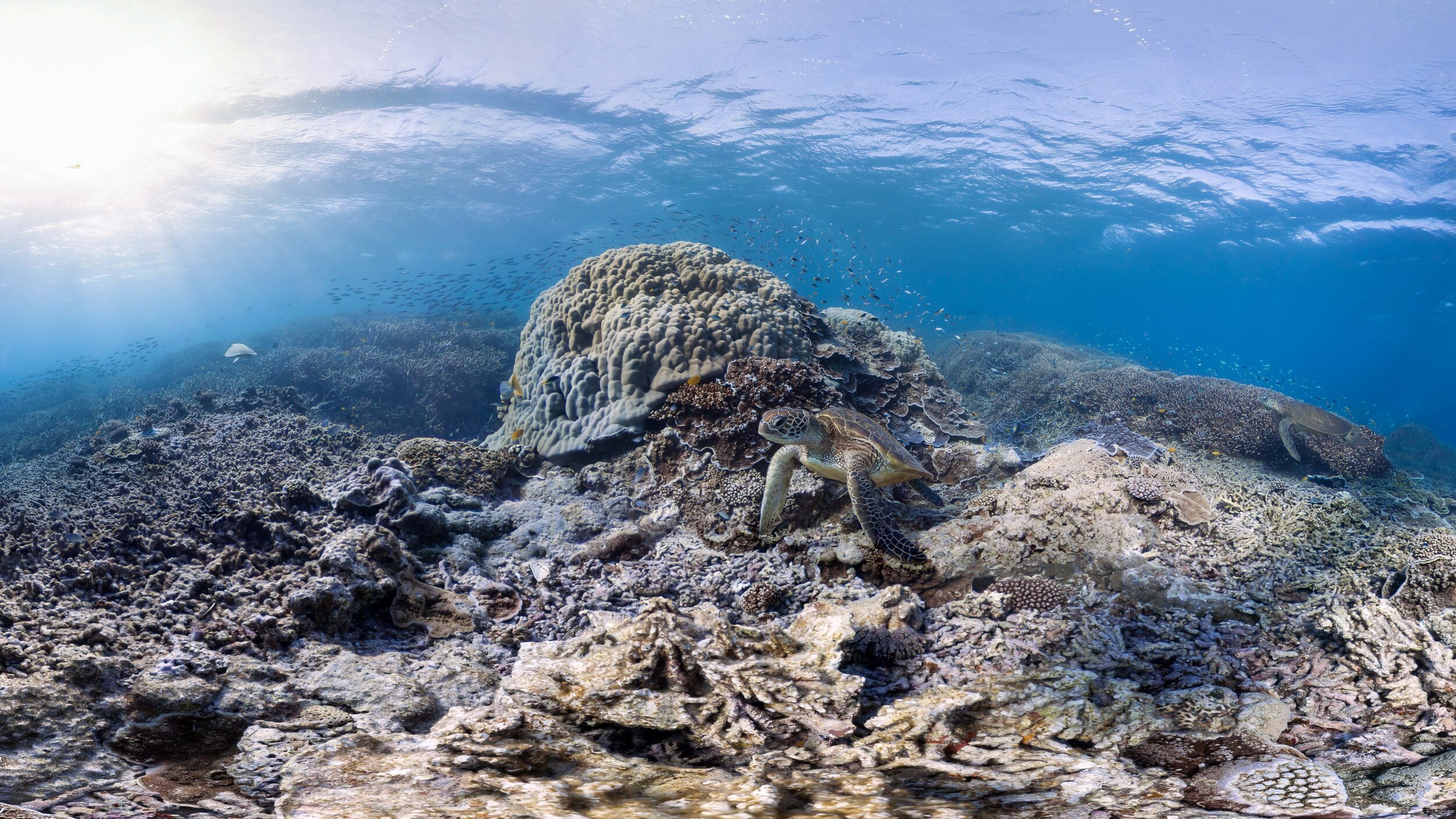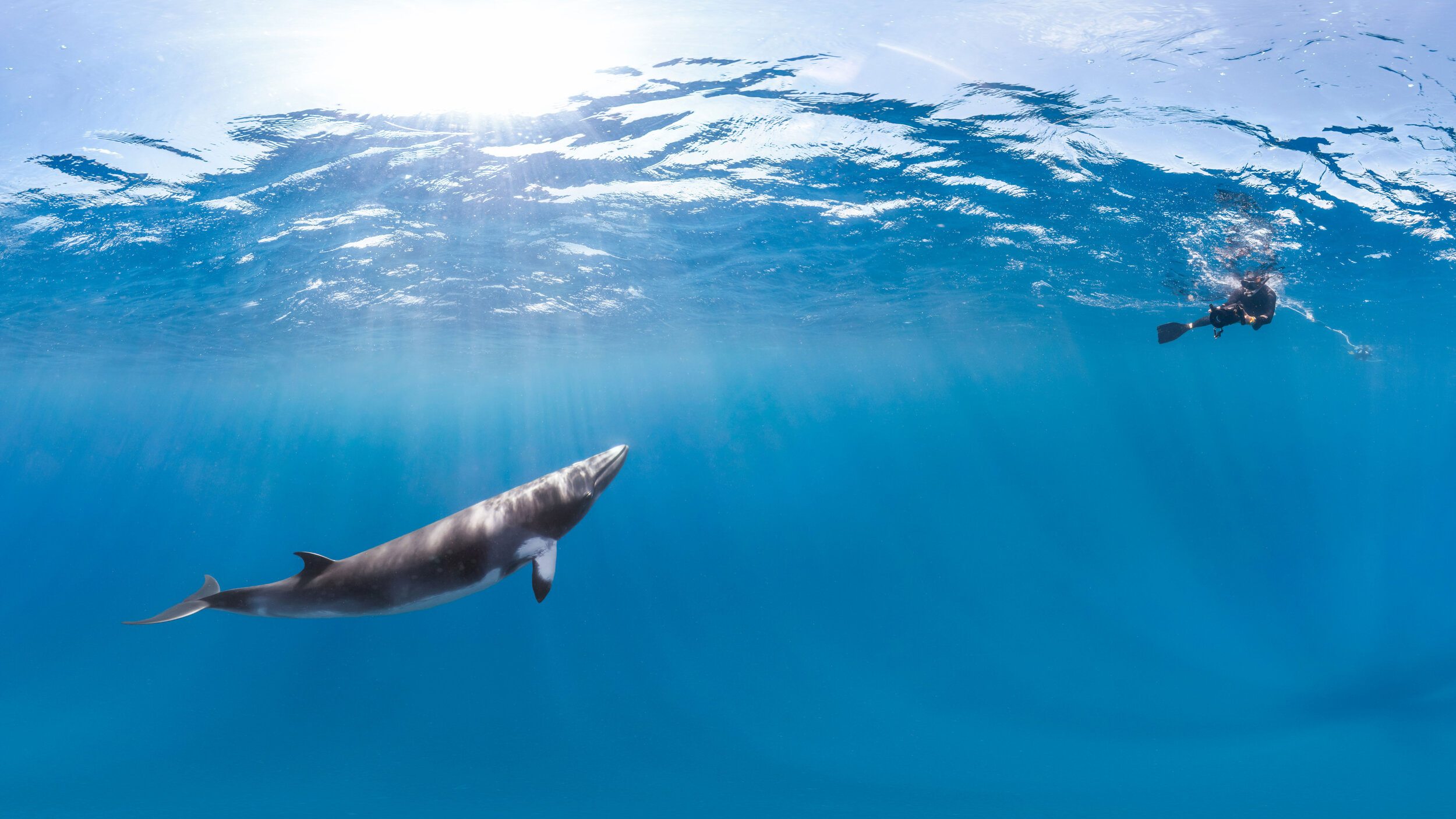The Stories Behind the Images
Fale Bommie, American Samoa, Underwater Earth/XL Catlin Seaview Survey/Christophe Bailhache
FALE BOMMIE
Christophe Bailhache, Underwater Earth, December 2014, Valley of the Giants, American Samoa
Image partners: AXA XL, National Marine Sanctuary of American Samoa, Google, Panedia, Fourth Element
Special thanks: Sophie Ansel
‘Fale Bommie’ is a huge Porites coral discovered by Fale Tuilagi in the ‘Valley of the Giants’ within the National Marine Sanctuary of American Samoa. Measuring in at 41 metres in circumference, and 7 metres high, this ancient giant is considered one of the largest corals on the planet. Given this type of coral grows very slowly, as little as 1 centimetre per year, “Fale Bommie” is estimated to be more than 500 years old meaning she is one of the most ancient life forms on the planet!
“The Valley of the Giants is one of those places with a strong sense of sacred. I felt humbled approaching such a magnificent ancient giant”.
The Sanctuary, Underwater Earth/XL Catlin Seaview Survey/Christophe Bailhache
THE SANCTUARY
Christophe Bailhache, Underwater Earth, June 2014, Julian Rocks Nguthungulli Nature Reserve, Cape Byron Marine Park, Australia
Image partners: AXA XL, Google, Panedia, Fourth Element
Julian Rocks Nguthungulli Nature Reserve is an impressive rock formation 2.5 kilometres off the shore of Byron Bay, Australia’s most easterly mainland point. Its Cape Byron Marine Park waters are home to large numbers of species, including leopard sharks and, seen here resting on the sandy bottom, wobbegong sharks. The area provides shelter for more than 500 tropical and temperate fish species. Big schools of snapper, trevally and mulloway regularly can be seen here. It is one of about a dozen critical habitats for the critically endangered grey nurse shark.
“There was so much to see on this memorable dive. I remember feeling like these wobbegongs were signposting me to enter deeper into the sanctuary of marine life”.
Doorway to Heaven, Underwater Earth/XL Catlin Seaview Survey/Christophe Bailhache
DOORWAY TO HEAVEN
Christophe Bailhache, Underwater Earth, January 2013, Batu Rufus, Raja Ampat, Indonesia
Image partners: AXA XL, Google, Panedia, Fourth Element
Special thanks: Aaron Spence
With 600 species of coral and more than 1,300 species of coral reef fish, Raja Ampat, considered the epicentre of the Coral Triangle, has the highest level of marine biodiversity in the world. Take a virtual dive to experience this underwater richness at the beautiful sloping coral garden of Batu Rufus, leading to a swim-through arch.
“Hovering there, taking in the breathtaking beauty, I remember thinking could this be a doorway to some kind of heaven?”
The Gardener, Underwater Earth/XL Catlin Seaview Survey/Christophe Bailhache
THE GARDENER
Christophe Bailhache, Underwater Earth, August 2014, Florida Keys National Marine Sanctuary, USA
Image partners: AXA XL, The University of Queensland, Google, Florida International University, Aquarius Reef Base, Coral Restoration Foundation, NOAA, Panedia, Fourth Element
Former commercial fisherman and tropical fish collector, Ken Nedimyer is one of today’s pioneers of coral reef restoration, harvesting and replanting corals in the hope of bringing endangered coral reefs back to life, and sharing his knowledge around the world. His work began here in 2003 in the Florida Keys National Marine Sanctuary. Today there are coral nurseries in every coral reef region of the world.
“When you get used to seeing coral reefs devastated by cyclones, bleaching, overfishing, and pollution, to then find someone fighting to reverse this trend instils hope in me”.
Last Cry For Help, Underwater Earth/XL Catlin Seaview Survey/Christophe Bailhache
LAST CRY FOR HELP
Christophe Bailhache, Underwater Earth, March 2016, Lizard Island, Great Barrier Reef, Australia
Image partners: AXA XL, Google, UNESCO, Exposure Labs/Chasing Coral, Panedia, Fourth Element
Special thanks: Jeff Orlowski, Lyle Vail (Lizard Island Research Station)
In 2016, the Great Barrier Reef suffered unprecedented mass coral bleaching as part of the Third Global Coral Bleaching Event. An estimated 30% of the Reef died as a consequence. Lizard Island in the far northern section was particularly hard hit. This image was captured during filming for the Emmy award-winning documentary film ‘Chasing Coral’.
“Nothing could have prepared me for this shoot. The ocean was overheating and the corals were fluorescing and bleaching everywhere I looked. This one coral struck me in particular. It felt like it was reaching up, signalling for help”.
Ningaloo Patchwork, Underwater Earth/Christophe Bailhache
NINGALOO PATCHWORK
Christophe Bailhache, Underwater Earth, August 2019, Whalebone, Muiron Islands, Ningaloo region, Australia
Image partners: Google, Parks and Wildlife Service/Department of Biodiversity, Conservation and Attractions (Government of Western Australia), UNESCO, Fourth Element
Whalebone is a dive site in the heavily protected South Muiron Conservation Area, named after a whalebone that has now been washed away, grown over, or reabsorbed into the fabric of the reef. Fishing is not permitted here and public moorings are provided for recreational visitors to help protect the area from anchor damage. This area is exposed to the swell and waves of the Indian Ocean meaning few branching corals can grow here. The reef, as a consequence, is dominated by a myriad of hard plating corals and stunning colourful soft corals.
“I was hit by an explosion of colour diving here. No wonder coral experts that come here are blown away”.
Rewilding, Underwater Earth /Christophe Bailhache
REWILDING
Christophe Bailhache, Underwater Earth, December 2019, North Bondi, Australia
Image partners: UNSW Sydney, Sydney Institute of Marine Science, Mission Blue, Ocean Lovers Festival, Fourth Element
Scientists from Operation Crayweed are bringing back crayweed to Sydney Coast, a Mission Blue Hope Spot. Crayweed, a locally extinct seaweed species, is transplanted onto mesh mats underwater allowing it to reproduce and settle onto surrounding bare rocks and provide new habitat for a diverse range of marine creatures. Here, Derrick Cruz and Maddy Langley (UNSW Sydney and Sydney Institute of Marine Science) measure the length of a crayweed transplant at North Bondi. Learn more or even volunteer your time at www.operationcrayweed.com.
“In my work I get to meet so many passionate people working tirelessly to save vital marine biodiversity, in this instance, restoring underwater forests by planting and allowing ‘craybies’ to populate”.
Dancer In The Blue, Underwater Earth/XL Catlin Seaview Survey/Christophe Bailhache
DANCER IN THE BLUE
Christophe Bailhache, Underwater Earth, October 2016, Lady Elliot Island, Great Barrier Reef, Australia
Image partners: AXA XL, Lady Elliot Island, Google, UNESCO, Project Manta, Panedia, Fourth Element
Located within the highest protection zone of the Great Barrier Reef, Lady Elliot Island is a haven for manta rays. There is still so much to learn about these intriguing and lesser-known giants of the sea. Thanks to their frequent visits, Lady Elliot Island has become one of the very few worldwide research bases for mantas. Scientists track the mantas using the pattern of spots on their underbelly, believed to be as unique to a manta as fingerprints are to humans.
“The manta ray has to be my most favourite of all marine creatures. Time stands still for me when I watch them glide and dance through the water.”
Schooling Jacks, Underwater Earth/XL Catlin Seaview Survey/Christophe Bailhache
SCHOOLING JACKS
Christophe Bailhache, Underwater Earth, July 2013, Lady Elliot Island, Great Barrier Reef, Australia
Image partners: AXA XL, Lady Elliot Island Resort, Google, UNESCO, Panedia, Fourth Element
Special thanks: Peter Gash
Lady Elliot Island, the southernmost coral cay of the Great Barrier Reef, is teeming with life underwater. Bigeye trevally, also called jacks, are frequently seen schooling. During the day they are stationary or slow-moving around the reef complexes, but at night, these aggregations dissolve, as the fish become more active, preparing for a night of hunting for their prey.
“I remember being mesmerised by this ever-evolving mass of jacks surrounding me with the SVII underwater camera system. I could have stayed there for hours”.
Desert Rose, Underwater Earth/Christophe Bailhache
DESERT ROSE
Christophe Bailhache, Underwater Earth, May 2017, Ulong Channel, Palau
Image partners: Bloomberg Philanthropies and Tiffany and Co. Foundation and Paul G Allen Family Foundation (as part of the 50 Reefs initiative), Google, Panedia, Fourth Element
Known for its strong currents through the naturally occurring channels, this renowned dive site draws crowds seeking an exhilarating drift dive. There’s much to see as you drift along, including gliding sharks, and numerous coral formations. The dive culminates calmly in a picturesque area abundant with huge lettuce corals, potentially the largest known patch in the world. These corals have grown up from the channel’s bottom as high as six metres in places. The folds of the corals provide refuge for the many small reef fish that have made this reef their home.
“I recall thinking these enormous lettuce corals looked like crystal layers of the curious desert rose - the rose-like formations of crystal clusters that are found in a completely different environment - the desert”.
Serene Gatekeeper, Underwater Earth/XL Catlin Seaview Survey/Christophe Bailhache
THE SERENE GATEKEEPER
Christophe Bailhache, Underwater Earth, May 2012, French Bommie, Heron Island, Great Barrier Reef, Australia
Image partners: AXA XL, The University of Queensland, Google, UNESCO, Panedia, Fourth Element
Special thanks: Heron Island Research Station
On the UNESCO World Heritage list since 1981, the Great Barrier Reef (GBR) is an icon of the natural world. The area contains the world’s largest collection of coral reefs, with 400 types of coral, 1,500 species of fish and 4,000 types of mollusks. It also holds great scientific interest as the habitat of threatened species such as the dugong and the large green turtle. Virtual dive this reef and look carefully for three such turtles hiding amongst the corals.
“This is an incredibly special image for me. This was one of the very first dives we made with the SVII camera on the GBR. I still remember the incredible connection I felt when I encountered this turtle. And given we used this image to launch our first underwater Google Street View collection, more people virtual dived this image in the first week of launch than have ever actually dived in person. Powerful stuff”.
Early Morning Traffic, Underwater Earth/XL Catlin Seaview Survey/Christophe Bailhache
EARLY MORNING TRAFFIC
Christophe Bailhache, Underwater Earth, April 2014, USAT Liberty Wreck, Tulamben, Bali, Indonesia
Image partners: AXA XL, Google, Panedia, Fourth Element
The USAT Liberty was a 120-metre-long, ex-American cargo ship which now rests just off a rocky Tulamben beach in the northeast of Bali. The Liberty was torpedoed by a Japanese sub in the Lombok Strait in 1942 but it did not sink. It made it to Tulamben where it remained beached until 1963. When Mount Agung erupted in 1963, the earth tremors pushed the vessel out into the sea where it rests today. The coral-covered wreck is one of Bali's most popular dives and it provides habitat for all manner of marine creatures including these curious-looking inhabitants, a school of bumphead parrotfish, who frequent the wreck at night leaving the site early each morning.
“Early morning dives make for challenging light conditions, but for this dive site, it meant we got to not only beat the hordes of tourist divers, but also greet the craziest bunch of bumphead parrotfish departing on their morning commute”.
Crazy Corals, Underwater Earth/Christophe Bailhache
CRAZY CORALS
Christophe Bailhache, Underwater Earth, June 2017, Palmyra Atoll, USA
Image partners: NOAA Fisheries, The Nature Conservancy, U.S Fish & Wildlife Service, Google, Panedia, Fourth Element
Special thanks: Sophie Ansel, Timothy Clark, Stefan Kropidlowski
‘Crazy Corals’ is named for the amazing diversity of coral shapes found at the site. Corals can form different shapes depending on the environment where they live. The same species may be flattened against the bottom in a high energy surf zone, be shaped like a column in a channel with moderate current flow or form giant elevated tables in a calm, inner lagoon. ‘Crazy Corals’ is one of the more protected sites in remote Palmyra Atoll, and this protection allows the corals to grow into shapes that would never survive in other locations.
“I was taken aback by the magical beauty of such a diverse and untouched underwater paradise. Simply mind-blowing”.
Connecting, Underwater Earth/XL Catlin Seaview Survey/Christophe Bailhache
CONNECTING
Christophe Bailhache, Underwater Earth, June 2014, Great Barrier Reef, Australia
Image partners: AXA XL, Google, UNESCO, Panedia, Fourth Element
Special thanks: Francesca Truter
Little is known about the population of dwarf minke whales that visit the Great Barrier Reef each winter. Queensland is the only place in the world where special ecotourism operations allow humans to get close enough to these whales whilst in the water. Like fingerprints are to humans, the white and grey markings on the sides of a minke whale are unique to each whale helping researchers track these beautiful creatures.
“The memory of the whales’ unusual and complex vocalisation, called the ‘star-wars’ call, still lives within me, as does this particular minke whale who seemed to have a thirst for human contact”.
Gliding, Underwater Earth/XL Catlin Seaview Survey/Christophe Bailhache
GLIDING
Christophe Bailhache, Underwater Earth, July 2013, Half Moon, Lighthouse Reef, Belize
Image partners: AXA XL, Google, UNESCO, Panedia, Fourth Element
Special thanks: Lynton Burger
The Belize Barrier Reef Reserve System, a UNESCO World Heritage site, contains the largest barrier reef in the Northern Hemisphere. The system illustrates a classic example of reef types through fringing, barrier and atoll, and its seven interconnected marine protected areas provide a haven for threatened species. Spotted eagle rays are considered near threatened on the IUCN Red List and need protection. These creatures are known at times to form aggregations, but most commonly they are seen alone, a sudden appearance providing delight for any expectant diver.
“Whilst this dive was rich with corals and small reef fish, it was strangely devoid of larger marine creatures. So when this eagle ray glided in to sight as we approached the drop-off, it gave me the moment I was waiting for - to capture this iconic reef creature”.
Underwater Earth’s SVII Camera in Raja Ampat, Indonesia, Underwater Earth/XL Catlin Seaview Survey/Aaron Spence
Introducing Underwater Earth’s custom-made underwater SVII camera system, designed not only to revolutionise scientific coral reef monitoring but also take the world virtual diving in Google Street View:
● Voted by Times Magazine amongst the top 100 new scientific discoveries of 2015;
● Invented and built by Underwater Earth in partnership with Panedia;
● Weighs roughly 65kg;
● With the assistance of a military-grade underwater scooter the camera system typically travels at three kilometres an hour, navigated by a diver;
● The orb (SVII’s head) houses three DSLR cameras and adapted lens allowing ultra-wide-angle photography, designed to capture 360-degree environments;
● Each camera is controlled by a tablet sitting within a custom-made underwater housing;
● Special software was developed to control the three cameras, allowing them to simultaneously fire;
● The camera system has an automatic mode for scientific surveys allowing cameras to fire every three seconds;
● There's also a manual mode allowing the diver to pick and choose where and when to take images and adjust multiple camera settings;
● The SVII camera systems have been used on over 70 missions across the globe, taking over 1 million panoramic images;
● Images have been made open-source online at the Global Reef Record for scientists to further their studies of coral reefs;
● Images are also used for communication, education and awareness programs touring the world online and in exhibits.
